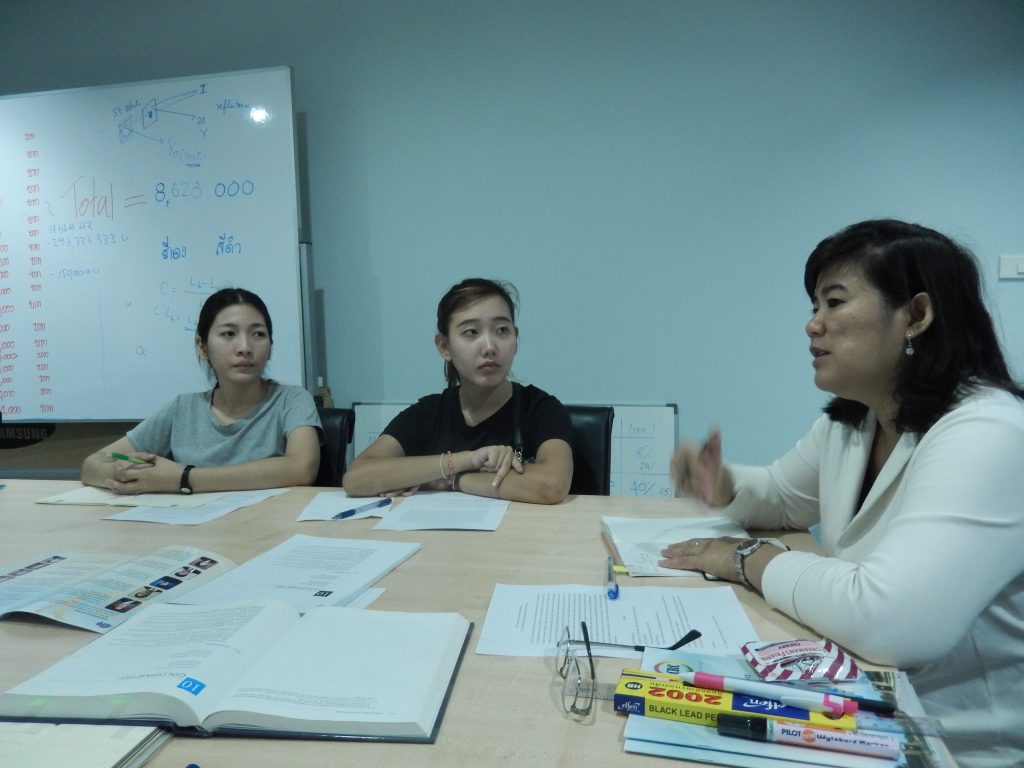The color vision group is led by
Dr. Phuangsuwan . She is interested in the mechanism of chromatic adaptation of the visual system. Concept of the recognized visual space of illumination RVSI proosed by Ikeda says that when an observer gets in a space he/she first recognize the space, understands the illumination filling in the space, and adapts to the illumination. Dr Phuangsuwan believes that the visual system can chromatically adapts even in a 2D picture and consequently he/she gets the color constancy for the picture if the 2D picture is perceived a 3D scene. She developed a D-up viewer by which a 2D picture can be perceived as a 3D scene and showedthe color constancy to hold for the 2D picture. Her belief further developed to the next theme, “Device dependence of color appearance”. Visual stimuli are usually presented on a 2D plane, a paper, a display, or a projector. The color appearance displayed on those devices should differ depending on how much the observer recognizes illumination in the stimuli. The dependence was clearly observed.
Article/Paper published
Year 2018
Color appearance of afterimages compared to the chromatic adaptation to illumination
Phuangsuwan C. and Ikeda M., Mepean J. Col. Res. And Appl. 2018 vol.43 pp.349-357
Chromatic adaptation in a 2D photograph demonstrated by a D-up viewer.
Phuangsuwan C, and Ikeda M. Col. Res. And Appl. 2018 Early View.
Color appearance of afterimages compared to the chromatic adaptation to illumination
Phuangsuwan C. and Ikeda M., Mepean J. Col. Res. And Appl. 2018 Early View.
Year 2017
Chromatic adaptation to illumination investigated with adapting and adapted color.
Phuangsuwan C. and Ikeda M. Col. Res. and Appl. 2017;42:571-579.
Senior project thesis:
Chromatic adaptation demonstrated for 2 pictures by Miss Wacharaporn Kaewpueak
Lightness constancy under typical shadows by Miss Ornanong Lamaichan
Visibility of test patch investigated by observing distance in simulating tunnel by Miss Jaruporn Panyachuen
Effect of lighting direction on visual performance in the elderly people by Miss Panarat Samniangsanoh
Packaging design of dried products based on memory color by Miss Waranya Pongsawat
Color perception of elderly people under various illuminance conditions by Miss Pijitra Sriwiroj
Chromatic adaptation shown by the adapting and adapted colors in the afterimage by Miss Janejira Mepean
Color appearance of objects under LED lights of various colors investigated by the elementary color naming method by Miss Chutipha Pipornpong
Ph.D. project topic:
Color appearance of objects under vivid LED lights.
Simultaneous color contrast in the retina or brain?
Year 2016
Initial visual information necessary for space recognition and understanding the illumination-Supplemental experiment
C.Phuangsuwan and M.Ikeda. Journal of Color Science Association of Japan, Vol.40 No.2 pp.60-66 (2016)
Indoor Illuminance Level Proper for Elderly People to See Signs from Outdoor.
C Pamano, M.Ikeda and C.Phuangsuwan. Proceeding of CSAJ2016 International Conference of the 47th Annual Meeting, Japan. pp. 154-156 (4-5 June 2016)
Whitness(W) and Lightness (L*) Relationship.
C.Phuangsuwan, S.Saingsamphun and M.Ikeda. Proceeding of CSAJ2016 International Conference of the 47th Annual Meeting, Japan. pp. 157-159 (4-5 June 2016)
Road luminance at tunnel and underpass entrance for safe driving of elderly people.
T. Takeuchi, C. Phuangsuwan, M. Ikeda, and N. Suwannasatit. Proceedings of ACA2016 The 3rd International Conference of Asia Color Association, China; pp. 192-195 (21-22 May 2016)
Comparison of the chromaticadaptation between LED and fluorescent lamps to investigate the color constancy by adapting –adapted color appearance.
C. Phuangsuwan and M. Ikeda. Proceedings of ACA2016 The 3rd International Conference of Asia Color Association, China; pp. 165-168 (21-22 May 2016)
Whiteness (W) and lightness (L*) relationship.
C. Phuangsuwan, S. Saingsamphun, and M. Ikeda. Proceedings of ACA2016 The 3rd International Conference of Asia Color Association, China; pp. 147-150 (21-22 May 2016)
Proper indoor illuminance for elderly people to see signs from outdoors.
M. Ikeda, C. Phuangsuwan, and C. Pamano. Proceedings of ACA2016 The 3rd International Conference of Asia Color Association, China; pp. 117-120 (21-22 May 2016)
Year 2015
Color constancy depends on initial visual information
Phuangsuwan, C., Ikeda, M. and Chunvijitra K. Proceeding of AIC 2015 Midterm Meeting of International Color Association. Japan pp. 798-803
Adapting and adapted colors under colored illumination
Ikeda, M., Phuangsuwan, C. and Chunvijitra K.
Proceeding of AIC 2015 Midterm Meeting of International Color Association. Japan pp. 793-797
Year 2014
Chromatic adaptation is not for object but for illumination.
Ikeda M., Naksuwan W. and Phuangsuwan C. Journal of Color Science Association of Japan 38 (2014) 174-175
Demonstration of Color Constancy in Photographs by Two Techniques: Stereoscope and D-up Viewer.
Phuangsuwan C., Ikeda M., and Shinoda H. Journal of Optical Review Vol. 21 No. 6 (2014) 810-815.
Photograph to demonstrate the lightness constancy of a real scene.
Phuangsuwan C., Ikeda M., and Mooklai S. Proceeding of ACA2014 Asia Color Association Taipei pp. 264-267
Lightness modification for a photograph to give natural impression as for the real scene.
Phuangsuwan C., Ikeda M., and Mooklai S. Journal of Color Science Association of Japan 38 (2014) 180-181.
Year 2013
Effect of initial visual information on construction of a space perception an on the color.
Phuangsuwan C. and Ikeda M. Proceeding of ACA2013 the 1st Asia Color Association Thailand (2013) 36-39.

